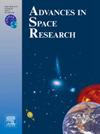Determination of the spacecraft’s spin axis orientation. Photometric patterns method
IF 2.8
3区 地球科学
Q2 ASTRONOMY & ASTROPHYSICS
引用次数: 0
Abstract
Near-Earth space is becoming increasingly congested; the number of satellites in low Earth orbit (LEO), where there is already the greatest spatial density of objects (including man-made debris), is increasing rapidly. Knowing the status of non-cooperative space objects is one of the requirements of space situational awareness (SSA). Assessing the dynamic properties of large inactive satellites and rocket bodies, such as their rotation period and the spatial location of the rotation axis, is necessary to predict their orientation. This information is critical to both the success of active debris removal (ADR) missions and improved orbital propagation of objects in LEO. Monitoring the state of RSO is carried out by various means, including using ground-based optical sensors by collecting photometric data, processing it and analyzing light curves. This paper presents a new method for estimating the orientation of the RSO rotation axis in space. This method relies on structural analysis of RSO light curves and the search for similar fragments, called ”photometric patterns,” in observations obtained from one or several sites simultaneously or over a short period of time. The method does not require knowledge of the RSO shape and does not impose strict requirements on the quality of photometric observations.
确定航天器的自旋轴方向。光度模式法
近地空间正变得越来越拥挤;低地球轨道(LEO)上的卫星数量正在迅速增加,而这里的物体(包括人造碎片)空间密度已经最大。了解不合作空间物体的状态是空间态势感知(SSA)的要求之一。评估大型非活动卫星和火箭体的动态特性,如旋转周期和旋转轴的空间位置,对于预测其方位十分必要。这些信息对于成功执行主动碎片清除(ADR)任务和改进低地轨道上物体的轨道传播都至关重要。监测 RSO 状态的手段多种多样,包括使用地面光学传感器收集光度数据、处理数据和分析光曲线。本文提出了一种估算 RSO 空间旋转轴方向的新方法。这种方法依赖于对 RSO 光曲线的结构分析,以及从一个或多个观测点同时或在短时间内获得的观测数据中寻找类似的片段(称为 "光度模式")。这种方法不需要了解 RSO 的形状,对测光观测的质量也没有严格要求。
本文章由计算机程序翻译,如有差异,请以英文原文为准。
求助全文
约1分钟内获得全文
求助全文
来源期刊

Advances in Space Research
地学天文-地球科学综合
CiteScore
5.20
自引率
11.50%
发文量
800
审稿时长
5.8 months
期刊介绍:
The COSPAR publication Advances in Space Research (ASR) is an open journal covering all areas of space research including: space studies of the Earth''s surface, meteorology, climate, the Earth-Moon system, planets and small bodies of the solar system, upper atmospheres, ionospheres and magnetospheres of the Earth and planets including reference atmospheres, space plasmas in the solar system, astrophysics from space, materials sciences in space, fundamental physics in space, space debris, space weather, Earth observations of space phenomena, etc.
NB: Please note that manuscripts related to life sciences as related to space are no more accepted for submission to Advances in Space Research. Such manuscripts should now be submitted to the new COSPAR Journal Life Sciences in Space Research (LSSR).
All submissions are reviewed by two scientists in the field. COSPAR is an interdisciplinary scientific organization concerned with the progress of space research on an international scale. Operating under the rules of ICSU, COSPAR ignores political considerations and considers all questions solely from the scientific viewpoint.
 求助内容:
求助内容: 应助结果提醒方式:
应助结果提醒方式:


